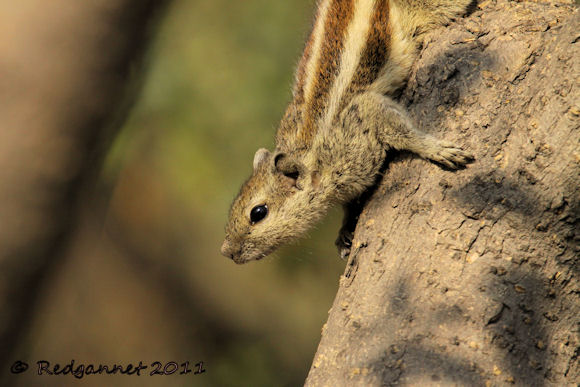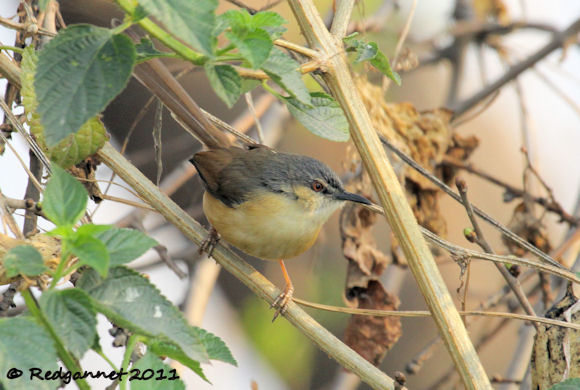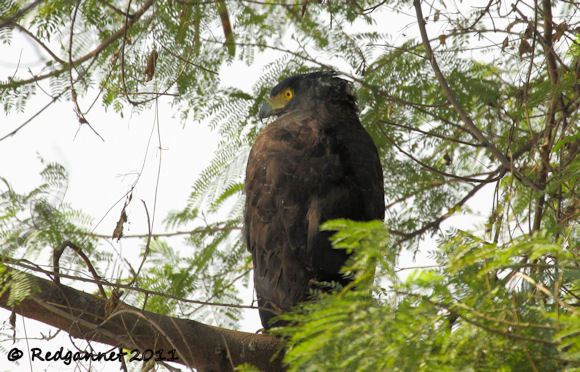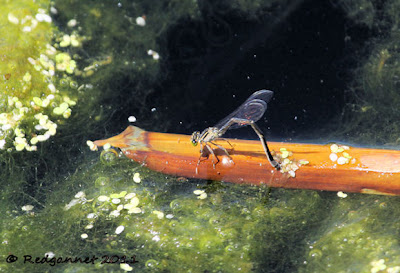Kalindi Kunj Crescent is a made up name for a spit of land, shaped like an agricultural hook, protruding upstream from the dam across the river Yamuna in New Delhi, India.
Things are never as easy as they should be when hiring taxis on the sub-continent and the problem on this occasion was that the bridge crossing the dam led out of New Delhi and into Uttar Pradesh State. Taxis are not allowed to cross state lines without a special licence, under pain of fine and my driver refused to embark on such a disreputable act. It was easy enough to walk the 600m to the crescent and birds were apparent straight away. Birding from the bridge might have been productive, but cyclists and pedestrians thronged the narrow walkway making it impractical, if not downright dangerous.
Once on the crescent, the noise of the traffic died away and I didn’t see another person until I returned to the bridge. One of the early birds was a small flock of Jungle Babblers. Out on the river, floating mats of weed held Purple Swamphens and Indian Pond Herons. Islands have formed and provided roosting opportunities for European Spoonbills, Black-tailed Godwits and plenty of waterfowl.
G.L. had mentioned Bar-headed Goose from his recent visit here. They did not show today, but were made up for by Greylag and Ruddy Shelduck. The ducks included Eurasian Wigeon, Northern Shoveler, Common Teal and Spot-billed Duck.
The crescent itself is a raised path lined with trees and bushes. For the first 300 m or so, the west side has reeds and rank vegetation alongside. I imagine that the appearance of this changes with the seasons and the river level. Google Earth shows huge mats of weed, as much as 200m wide, held back by the barrage. Today, the weed was minimal in comparison.
There is a low wall with a metal fence which shows that the spit is supposed to be here rather than just being an island formed by an agglomeration of weed over the years. This Indian Robin and a Bluethroat favoured the wall and the railing as somewhere to hang out.
In the lower trees were Lesser Whitethroat, Common Tailorbird and Yellow-bellied Prinia. A tiny Phyloscopus sp kept me busy for a while until I decided upon Greenish Warbler.
House Crows are always abundant in New Delhi, and the crescent seemed to have its fair share. They were very noisy this morning and appeared to be following me and calling to mark me out as a threat.
A Spotted Owlet flushed from a low tree ahead and distracted the attention of the crows for a while. The owl looked very discomfited to be attracting so much fuss and dropped onto one of the crows in an effort to shoo it away. Asian Pied Starlings joined in with the mobbing as did a Blyth’s Reed Warbler and a Three-striped Squirrel.
Yellow-bellied Prinias were common all along the length of the spit and were quite confiding and accomodating in response to a pish.
About half way along its 700m length, the crescent begins to hook around to the right (east). A pair of Black Ibis flushed from the water’s edge. Towards the end of the spit, another island has formed and held Grey heron, Glossy ibis and Wood Sandpiper. As I turned around, a large dark shape in a tree caught my attention. It was a Crested Serpent Eagle, which gave me another short respite by taking the noisy crows with it as it flew.I retraced my steps to get back to the bridge, heading home. As I passed the spot where the owls had been earlier, I stopped to watch the warblers and try to get a few more pictures. An Orange-headed Thrush suddenly appeared in a nearby bush and just as quickly, it was gone.
The river here is quite smelly and the crows were intrusive into what would otherwise have been a very pleasant morning. The birding was productive with over 60 species seen. I had asked my driver to wait for me at the car park at the end of the bridge. This involved a walk of 1.2kms in order to find him again, which was a bit of a drag. It cost IR700 for the return journey and 4 hours waiting.
There were other taxis and tuk-tuks that crossed the bridge as I was walking. In future, if my taxi does not hold the required licence, I will just get him to drop me and use one of the other cabs to get across the bridge.
Downstream, a few sandy islands wallowed in the river like a bather in a bubblebath. From my biology field-trip to a sewage farm at the age of twelve, I recall that foam at the outfall is an indication that the water is clean. There must have been a qualifier to that but I don't remember what it was. The islands held a few River Lapwing and were reported to harbour Small Pratincole further downstream.
Bird species; 63
Great Cormorant 1, Little Cormorant 3, Grey Heron 15, Purple Heron 2, Great Egret 1, Intermediate Egret 3, Cattle Egret 1, Indian Pond Heron 30, Painted Stork 1, Black-headed Ibis 1, Indian Black Ibis 8, Glossy Ibis 15, Eurasian Spoonbill 2, Greylag Goose 40, Ruddy Shelduck 8, African Comb Duck 6, Eurasian Wigeon 500, Gadwall 20, Eurasian Teal 12, Spot-billed Duck 12, Northern Shoveler 500, Black Kite 150, Crested Serpent Eagle 1, White-breasted Waterhen 1, Purple Swamphen 80, Common Moorhen 6, Common Coot 400, Black-winged Stilt 300, Pied Avocet 14, River Lapwing 8, Red-wattled Lapwing 25, White-tailed Lapwing 2, Black-tailed Godwit 15, Common Greenshank 1, Wood Sandpiper 4, Common Sandpiper2, Ruff 60, Yellow-legged Gull 2, Black-headed Gull 2, Eurasian Collared Dove 2, Rose-ringed Parakeet 1, Greater Coucal 2, Spotted Owlet 2, White-throated Kingfisher 3, Hoopoe 3, Plain Martin 8, Red-vented Bulbul 3, Orange-headed Thrush 1, Bluethroat 1, Indian Robin 2, Yellow-bellied Prinia 8, Common Tailorbird 3, Lesser Whitethroat 6, Blyth’s Reed Warbler 1, Greenish Warbler 1, Red-breasted Flycatcher 2, Jungle Babbler 5, Purple Sunbird 2, Black Drongo 3, Rufous Treepie 2, House Crow 200, Common Myna 8, Asian Pied Starling 12.
Mammal species; 3
Three-striped Squirrel 8, Nilgai 3, Common Mongoose 1.

















































